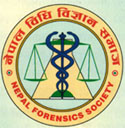NEPAL FORENSIC SOCIETY
Registered under the Nepal Law, Reg.No.622/053-54
|
|
JUSTICE BY FORENSIC SCIENCE
|
Source: Wikipedia, the free encyclopediaForensic Ballistics In the field of forensic science, forensic ballistics is the science of analyzing firearm usage in crimes. It involves analysis of bullets and bullet impacts to determine the type and caliber of the firearm fired. Rifling, which first made an appearance in the 15th century, is the process of making grooves in gun barrels that imparts a spin to the projectile for increased accuracy and range. Bullets fired from rifled weapons acquire a distinct signature of grooves, scratches, and indentations which are somewhat unique to the weapon used. The first firearms evidence identification can be traced back to England in 1835 when the unique markings on a bullet taken from a victim were matched with a bullet mold belonging to the suspect. When confronted with the damning evidence, the suspect confessed to the crime. The first court case involving firearms evidence took place in 1902 when a specific gun was proven to be the murder weapon. The expert in the case, Oliver Wendell Holmes, had read about firearm identification, and had a gunsmith test-fire the alleged murder weapon into a wad of cotton wool. A magnifying glass was used to match the bullet from the victim with the test bullet. Calvin Goddard, physician and ex-army officer, acquired data from all known gun manufacturers in order to develop a comprehensive database. With his partner, Charles Waite, he catalogued the results of test-firings from every type of handgun made by 12 manufacturers. Waite also invented the comparison microscope. With it, two bullets could be laid adjacent to one another for comparative examination. In 1925 Goddard wrote an article for the Army Ordnance titled "Forensic Ballistics" in which he described the use of the comparison microscope regarding firearms investigations. He is generally credited with the conception of the term "forensic ballistics", though he later admitted it to be an inadequate name for the science. In 1929 the St. Valentine's Day Massacre led to the opening of the first independent scientific crime detection laboratory in the United States. Source: Internet |
|
|



